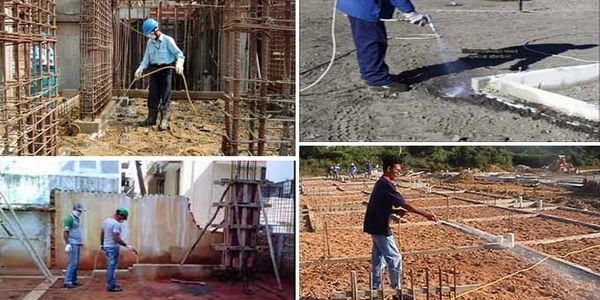Signed in as:
filler@godaddy.com
Signed in as:
filler@godaddy.com

Pre-construction anti-termite treatment is a preventive method applied to buildings or structures during the construction phase to protect them from future termite infestations. This process involves treating the soil beneath and around the foundation with termiticides (chemicals designed to kill or repel termites) to create a barrier that prevents termites from entering the building. The treatment is done in various stages to ensure long-term protection.
Steps involved in pre-construction anti-termite treatment:
1. Soil Treatment:
Before the foundation is laid, the soil is treated with termiticides. The goal is to create a chemical barrier between the ground and the building. This treatment targets subterranean termites that come from the ground.
2. Foundation Trenching:
A trench is dug around the foundation's perimeter and filled with termiticides. This creates a protective layer that termites cannot penetrate. This is done before pouring the concrete slab or before constructing the walls.
3. Treatment of Wall Voids and Pipes:
As the walls and plumbing are constructed, termiticides are applied to critical areas like wall junctions and pipe penetrations where termites might enter.
4. Slab Treatment:
After the foundation or concrete slab is poured, the area is sprayed with termiticides to form a barrier under the slab.
5. External Perimeter Treatment:
Once construction is completed, the external perimeter of the building is also treated to prevent termites from approaching the structure.
1. Long-lasting protection:
Provides long-term protection by preventing termites from entering the structure right from the start.
2.Cost-effective:
Prevents costly damage in the future, as termite infestations can severely weaken the structure.
3. Comprehensive coverage:
Ensures the entire building, including foundations, walls, and perimeters, is protected. This treatment is essential for areas where termites are prevalent and is often a requirement in building codes or for obtaining certain property insurance.
Pre-construction anti-termite treatment is a preventive method applied during building construction to protect against future termite infestations. It involves treating the soil, foundation, and building perimeter with termiticides to create a barrier that prevents termites from entering. Key steps include soil treatment, trenching around the foundation, treating wall voids and pipes, and spraying under the slab. This process offers long-term protection, is cost-effective, and ensures comprehensive coverage of the structure from termites.

Post-construction anti-termite treatment is a method applied to an existing building to eliminate or prevent termite infestations after the structure has been built. This treatment is typically required when there is a known termite infestation or as a preventive measure in termite-prone areas.
1. Inspection:
A thorough inspection is conducted to identify termite entry points, nesting sites, and the extent of damage. This helps to determine the areas that need treatment.
2. Drilling and Injection:
Small holes are drilled into the floors, walls, or foundations where termite activity is suspected or as a preventive measure. Termiticides are then injected into these holes to reach termite colonies deep in the soil or wood structures.
3. Trenching:
Similar to pre-construction treatment, a trench is dug around the building’s perimeter and filled with termiticides to create a chemical barrier. This prevents termites from entering the structure from the outside.
4. Surface Treatment:
The infested or vulnerable areas, such as wooden structures, are sprayed or painted with termiticides to kill existing termites and prevent future infestations.
5. Wall and Foundation Treatment:
Termiticides are injected into cracks and crevices in the walls or foundations to stop termites from traveling through these areas.
6. Bait Stations (Optional):
Termite bait stations may be placed around the building’s perimeter. These contain slow-acting toxins that worker termites take back to the colony, effectively eliminating the entire colony over time.
1. Eliminates active infestations:
It targets and eradicates existing termite colonies within and around the structure.
2. Prevents future infestations:
By creating chemical barriers and treating vulnerable areas, it helps prevent termites from returning.
3. Non-invasive solutions available:
In some cases, non-invasive methods such as baiting systems can be used, minimizing damage to the building during treatment.
Post-construction treatments are usually needed when termites are discovered in or around a building, but they can also be applied as a preventive measure in areas at risk of infestation.
Post-construction anti-termite treatment is applied to existing buildings to eliminate or prevent termite infestations. It involves inspecting for termite activity, drilling holes in infested areas to inject termiticides, trenching around the building’s perimeter, and treating surfaces and foundations. Bait stations may also be used to target colonies. This treatment is effective in eradicating active infestations and creating a protective barrier to prevent future termite problems.
Copyright © 2025 coomarservices - All Rights Reserved.
We use cookies to analyze website traffic and optimize your website experience. By accepting our use of cookies, your data will be aggregated with all other user data.